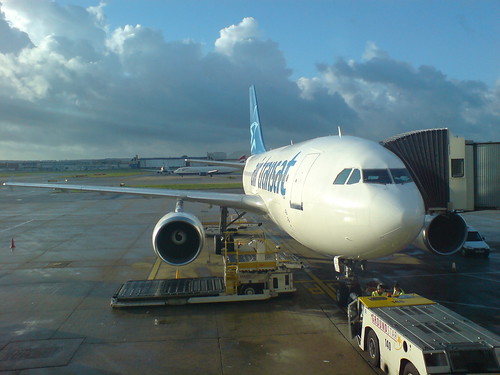(Sources contributing to this hybrid report: Washington Post; Business Week; Bloomberg)

Boeing Co. said Thursday its long-delayed 787 jetliner will be ready for its maiden test flight by year’s end and its first delivery in the fourth quarter next year.
The initial flight of the next-generation plane, built for fuel efficiency with lightweight carbon composite parts, was originally slated for the fall of 2007. But production problems delayed the passenger jet five times and first deliveries are more than two years behind their original schedule.
After so many false starts, airline customers have grown irritated and analysts skeptical of the company’s timetables for the 787. Billions of dollars in penalties and expenses are expected from the delays, and they’ve hurt the Chicago company’s credibility.
Boeing postponed the new composite-plastic plane for the fifth time June 23, saying no new schedule could be given until it decided how to reinforce sections where the wings join the body after tests revealed unexpected stresses. Boeing has lost about half its market value since the 787’s first delay in October 2007, hurt by parts shortages, defects, redesigns and incomplete work from vendors. Chief Executive Officer Jim McNerney has said the company let down customers on its most successful sales campaign ever.
With the 787, Boeing has taken a new approach to building airplanes, relying on overseas suppliers to build huge sections of the plane that are later assembled at the company’s commercial aircraft plant near Seattle.
But ill-fitting parts and other problems have hampered production. The latest delay came in June, when the company said it needed to reinforce areas close to where the wings and fuselage join.

There are 850 of the jets on order even after airlines canceled 73 this year. Boeing is using lightweight composites, instead of aluminum, and more electrical power to increase fuel efficiency on the Dreamliner. The planes have an average price of $178 million.
Boeing also pushed back its production plans today, saying it will ramp up to building 10 Dreamliners a month in late 2013 rather than 2012. The 787-9 version will be delivered in the fourth quarter of 2013, executives said on the call. Chief Financial Officer James Bell said in July he was reviewing whether the setbacks had pushed costs above expected revenue in a certain block of sales, which would produce a reach-forward loss.
Engineers are completing the design for the reinforcements of sections along the top of the wing and will begin installing the parts within the next few weeks, Boeing said.
The company and some analysts say the 787 will eventually will prove a financial and technological success. But Wall Street remains skeptical. The company’s stock price jumped the most since December in New York trading after saying it still expects the 787 Dreamliner program to be profitable following a $2.5 billion third-quarter charge for the delayed plane. Boeing rose $3.30, or 6.9 percent, to $51.12 at 10:18 a.m. in New York Stock Exchange composite trading. The shares earlier climbed 9.3 percent, the biggest intraday jump since Dec. 8.
The 787 is Boeing’s first all-new jetliner since the 777, which airlines began flying in 1995.




